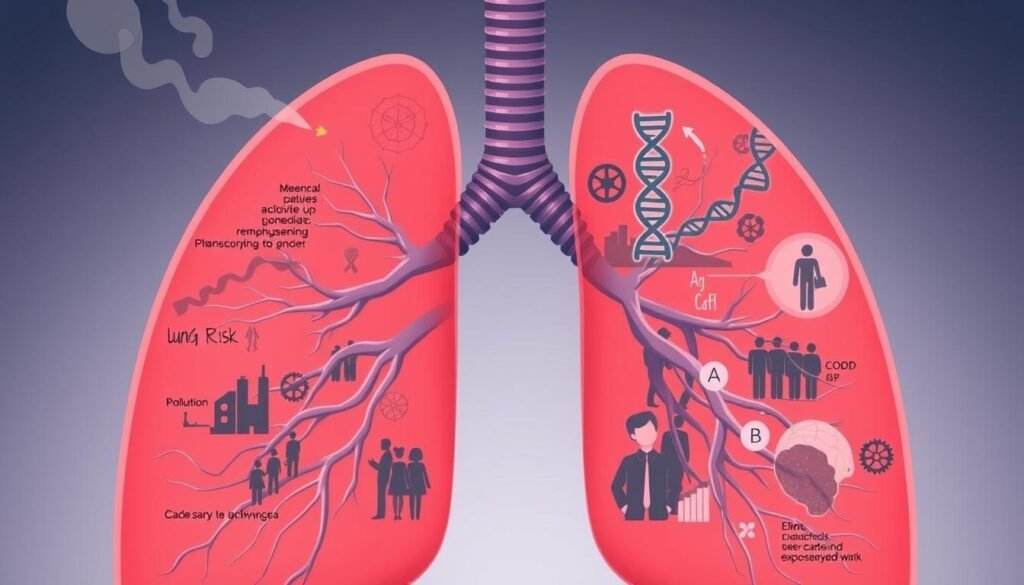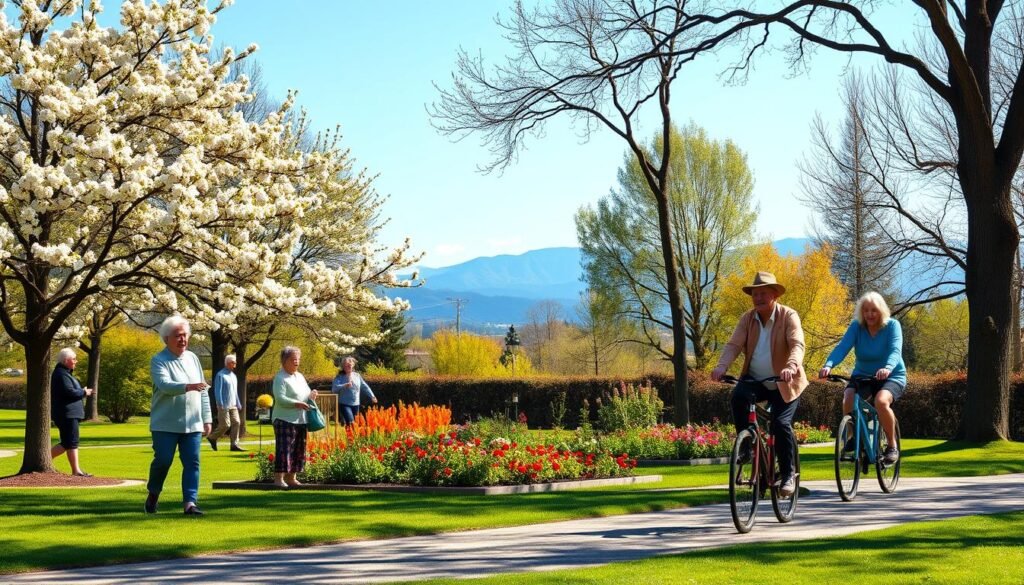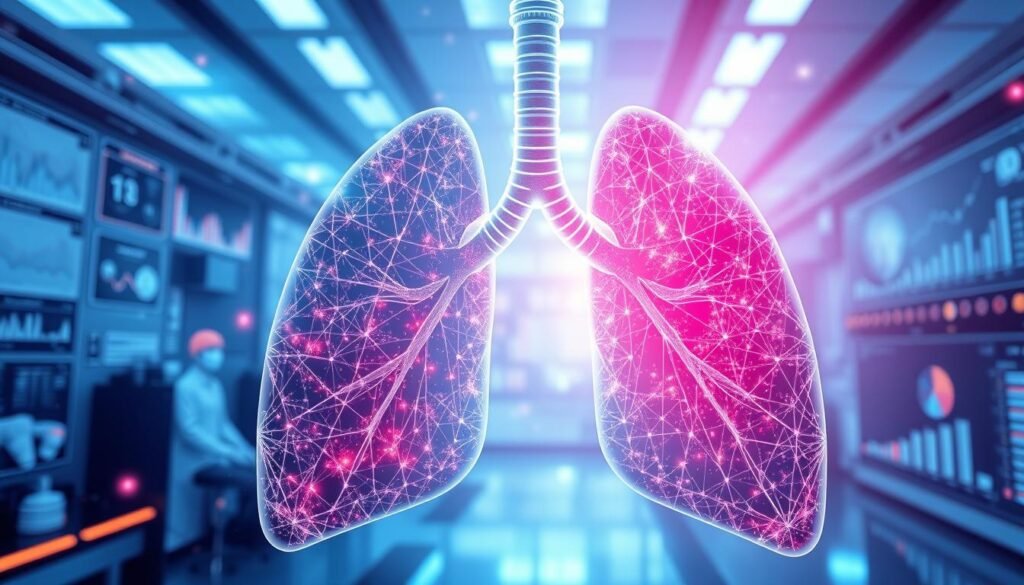Did you know 68% of lung cancer patients in the U.S. are 65 or older when diagnosed? This fact shows how lung cancer, especially non-small cell lung cancer (NSCLC), is more common in older people. With people living longer and a growing number of people over 65 in the future, understanding age-related risk factors for this disease is crucial.
Knowing how age affects NSCLC can help us prevent it and find it early. This can make a big difference for older people’s health. This part explains why getting older increases the risk of lung cancer. It highlights the importance of being aware and taking steps to stay healthy.
Key Takeaways
- Majority of lung cancer diagnoses occur in individuals aged 65 and older.
- Life expectancy has increased significantly, affecting lung cancer statistics.
- Understanding age-related risk factors is crucial for effective prevention.
- Demographic trends suggest a growing older population at risk for NSCLC.
- Awareness and early detection can significantly improve treatment outcomes.
The Growing Concern of Lung Cancer in Older Adults
Lung cancer is a top cause of cancer deaths, especially in older adults. Over 40% of lung cancer cases are in people over 70. The average age for finding lung cancer in the U.S. is 70. This shows more older people are getting lung cancer. It’s important to focus on how we can prevent and raise awareness for this age group.
More than half of advanced lung cancer cases are in those 65 and up. Lung cancer deaths in women over 70 have gone up since 2000. With many cases in those 70 or older, we need effective plans to fight this rise.
Older adults need care that meets their specific needs, especially in hospitals. Studies show people over 80 in trials have less serious side effects and live just as long. This shows we must pay special attention to their health care needs.
We must understand lung cancer in older adults as our population gets older. We need early detection, and treatments that work for them. Raising awareness can help lower lung cancer rates and deaths in older adults. Preventive health care for them is key to lessen this disease’s impact. Health guides, like treatment guidelines for elderly patients, are great resources.
| Age Group | Lung Cancer Incidence (%) | Mortality Rates (%) |
|---|---|---|
| 60 – 69 | 30 | 22 |
| 70 – 79 | 40 | 30 |
| 80+ | 14 | 50 |
Understanding Non-Small Cell Lung Cancer (NSCLC)
Non-small cell lung cancer (NSCLC) is found in about 84% of lung cancer cases in the U.S. It’s the most common lung cancer type. It has different traits compared to small cell lung cancer. Knowing about NSCLC’s main kinds helps understand how it behaves and progresses.
- Adenocarcinoma
- Squamous cell carcinoma
- Large cell carcinoma
- Adenosquamous carcinoma
- Sarcomatoid carcinoma
Each subtype of NSCLC reacts differently to treatments. This adds to the complexity of lung cancer. For example, adenocarcinoma is more common in women and found often in the lungs’ outer areas. Squamous cell carcinoma is linked to smoking and is found in the lungs’ central parts.
The outlook for NSCLC depends on when it’s found. Early-stage, localized tumors have a 63% survival rate over five years. However, metastatic NSCLC has only a 7% survival rate. People are usually diagnosed around the age of 70.
Understanding lung cancer biology helps with early diagnosis, choosing treatment options, and improving outcomes for NSCLC patients.
Why Older Adults Are More Likely to Be Diagnosed with NSCLC
Lung cancer is a big challenge for older people. This is because of risk factors and changes from aging. It’s important for them to know about the risk as they get older.
Age-Dependent Risk Factors
As people get older, they are more exposed to lung cancer risks like smoking and pollution. A lot of older patients find out they have lung cancer at a late stage. For example, 75% of people between 20 to 29 get a late-stage diagnosis, but this number falls to 40% for those 70 to 79.
Most lung cancer cases are in people 65 and older. This shows why screening is crucial for them. The average age at diagnosis is 71, showing risk goes up with age.
Biological Changes in Aging
Aging affects the immune system and lung structure, making older adults more prone to NSCLC. These changes make it harder for them to fight off lung cancer. However, early diagnosis in those over 50 has improved from 2010 to 2018.
It’s vital for older adults to look out for lung cancer signs. Getting checked early can make a huge difference. If you want to know more about early signs of lung cancer, visit this resource.
Key Lung Cancer Risk Factors in Older Adults
As people get older, it’s crucial to know what raises the chance of lung cancer. We focus on the main causes of lung cancer in the elderly.
Smoking and Its Long-Term Effects
Smoking is the top reason for lung cancer. In older adults, years of smoking have serious effects. Research shows that smoking causes around 80% of lung cancer deaths.
Men over 65 have the highest lung cancer rates due to smoking. Women in this age group who have smoked at least 100 cigarettes in their lifetime also face a higher risk. This risk goes up the longer it’s been since they quit smoking.
Secondhand Smoke Exposure
Lung cancer risk increases with secondhand smoke exposure. Older adults often face this risk from past environments.
They might have been around a lot of secondhand smoke at work or socially. This increases their chances of getting lung cancer.
Occupational Hazards
Jobs with certain risks can increase lung cancer chances in the elderly. Many have been exposed to harmful substances like asbestos and diesel exhaust. These exposures greatly raise lung cancer risk, especially for smokers.
Being around lots of chemicals at work also adds to the risk. It makes lung cancer more likely for older adults.

The Role of Genetics in NSCLC
Genetics are key in Non-Small Cell Lung Cancer (NSCLC). They help us know how some people might get lung cancer. If someone’s family has cancer history, they might be more at risk. This shows why genetic tests are important, especially for older people.
Genetic Predisposition and Family History
Having cancer in your family means you might inherit risks for NSCLC. Many with NSCLC have more than two gene changes. Some genes, like EGFR, MET, and RET, change more in people who never smoked. Knowing this helps doctors screen people better and prevent cancer early.
Identification of Genetic Markers
Finding genetic markers helps us understand NSCLC risks better. Studies link some mutations to age and if someone smokes or not. For example, ALK, BRAF, and MET mutations are common in people over 55. This knowledge helps doctors watch patients closely and choose the best treatment.
| Mutation Type | Prevalence in NSCLC Patients | Associated Age Group |
|---|---|---|
| EGFR | Higher in non-smokers | All ages |
| ALK | Common | Younger patients |
| BRAF | Common | Young adults |
| MET | Frequent | Aged 55 and older |
Triggers for NSCLC Symptoms in the Elderly
Finding NSCLC symptoms in older adults can be tricky. Many older people have other health problems, which can hide or mimic lung cancer symptoms. It’s crucial to spot these signs early for the best care.
Common Signs and Symptoms of NSCLC
The usual NSCLC symptoms are:
- Worsening cough
- Chest pain
- Weight loss
- Shortness of breath (dyspnea)
- Hemoptysis (coughing up blood)
- Malaise and fatigue
- Hoarseness
These symptoms might also show up due to other illnesses in the elderly. It’s important to check thoroughly to tell them apart from lung cancer signs.
The Impact of Comorbid Conditions
Health issues like COPD, heart problems, and diabetes can cover up NSCLC symptoms, leading to late diagnoses. Having many health problems affects both how symptoms appear and the treatment plan. It’s key to understand this interplay for managing older patients’ health well.
Challenges in Early Detection among Older Adults
Finding lung cancer early is hard, especially for older people. It’s key to get screened early to fight lung cancer better. Many things block quick finding and check-ups, making health visits very important for older folks.
Barriers to Screening and Diagnosis
Older people face a lot of challenges when trying to detect lung cancer early. The main issues are:
- Limited mobility that restricts access to healthcare facilities.
- Healthcare providers sometimes undervalue the cancer risk in older patients.
- Inadequate awareness about symptoms can delay seeking medical attention.
- Inconsistent screening protocols contribute to confusion among patients and providers.
Because of these barriers, many older adults might not get the screening they need. This makes their treatment options limited and outcomes worse.
The Importance of Regular Health Checkups
Checkups are crucial for everyone, but they’re especially important for older adults. They help find lung cancer early. And they let doctors keep an eye on other health issues that could raise cancer risk. Staying on top of these visits can help more people know they need to be screened for lung cancer.
Talking openly with your doctor is key. Talking about screening options can help find cancer early. Pushing for better access to screenings will help improve health results for older adults.
The Impact of Lifestyle Choices on Lung Cancer Risk
Lifestyle choices have a big impact on lung cancer risk, especially for older adults. Eating right and staying active play a huge part in health and lung cancer risk. This piece looks into how changing our lifestyle can help prevent lung cancer and improve lung health.
Nutrition and Its Role in Cancer Prevention
What we eat is key for fighting cancer. Eating healthy strengthens our body’s defense against lung cancer. A diet full of fruits and veggies lowers cancer risk. On the other hand, processed and fried foods may increase disease risk. Adding fiber and antioxidants to meals is good for the immune system and helps control weight, important in battling lung cancer.
Certain foods, like those with arsenic and bad fats, can raise lung cancer risk. But whole foods and balanced meals can help us live longer and fight cancer. Older adults should learn more about this by looking at further studies.
Physical Activity and Lung Health
Being active is critical in preventing lung cancer. It boosts the immune system and helps keep weight healthy, lowering cancer risk. Not exercising enough is linked to higher cancer risks. This shows how important it is for older adults to include fitness in their routines.
Simple exercises like walking, yoga, or swimming can improve lung function and health. Being active also helps the heart and mind. Older adults should make exercise a regular part of their life to help prevent lung cancer and boost overall health.

Management and Treatment Options for NSCLC in Older Adults
Treating lung cancer in older adults requires special attention to their unique needs. Knowing about various treatments helps come up with personalized plans for them. This is key in dealing with their specific health situations.
Personalized Treatment Strategies
Personalized care is crucial for older patients with non-small cell lung cancer (NSCLC). Some over 80 don’t get treated after finding out they have stage 3 lung cancer. Often, this is due to wrong ideas about age and treatment success. Studies show older people can do as well as younger ones with certain surgeries.
It’s also key to test for genetic markers in NSCLC. This way, doctors can pick therapies that target these specifics, improving treatment results.
The Importance of Multidisciplinary Care
A team approach is essential in treating lung cancer in older adults. This brings together doctors from various fields to offer all-around care. It allows for handling other health issues while picking treatments like stereotactic body radiotherapy (SBRT). This is especially good for those over 90, being both safe and effective.
Older adults often do well with surgery and have good survival rates. This holds true for both minimally invasive surgeries and traditional open chest ones.
New targeted therapies, even those for specific genetic changes, are well-tolerated by older patients. Using chemoradiation wisely can also improve their outlook. By using a team care model, emotional support is boosted, making sure treatments improve life quality for lung cancer patients.
Research Insights on NSCLC Risk Factors
Research is key to understanding how aging affects non-small cell lung cancer (NSCLC). New studies give us deeper insights into age-related risk factors for lung cancer. By using high-tech methods, scientists are looking at lots of data to find patterns. These could help predict this disease.
Recent Studies on Aging and Lung Cancer
A large study showed a concerning trend. It looked at 2,148 new lung cancer cases from 2009 to 2014. About 28.4% of these patients didn’t receive any treatment. This was more common in patients older than 70. It’s clear we need to do better in treating older patients.
Another issue is the effect of income on treatment. People with lower incomes, especially those on Medicaid, were less likely to get treated. They had a 1.75 times higher chance of not being treated compared to wealthier patients. This shows big gaps in healthcare access based on income.
Evidence from Deep Learning Approaches
Deep learning is changing the game in NSCLC research. It’s helping find links between patients’ characteristics and their lung cancer risk. For instance, things like chronic kidney disease and heart attacks seemed tied to not getting treatment. With deep learning, we can get better at diagnosing lung cancer early. This could lead to better prevention and treatment methods.

Preventative Measures for Older Adults
Preventative measures are vital for lowering lung cancer risk in older adults. Public health efforts are key to making more people aware of lung cancer. They focus on the importance of screenings and education for those at high risk.
Public Health Initiatives
Many public health initiatives aim to increase understanding of lung cancer risks. They stress the need for regular screenings and promoting a healthy lifestyle. Efforts to teach older adults about the dangers of smoking and early detection benefits are reducing lung cancer rates.
However, only 14.4% of those eligible got screened for lung cancer last year. This shows we need to focus more on making screening more accessible and educating people about it. Checking reputable health organizations for advice can also help increase screening participation.
The Role of Vaccination and Lifestyle Changes
Vaccinations play a critical role in the lung health of the elderly. They help prevent respiratory infections, lowering lung cancer risks. Making vaccines easy to get can lead to more people getting them, which helps in preventing cancer.
Adopting a diet rich in fruits and veggies can cut cancer death risks by 10%. Regular exercise also decreases the chance of various cancers. Community programs promoting a healthier lifestyle can improve life quality for seniors while preventing cancer.
| Preventative Measure | Impact on Cancer Prevention |
|---|---|
| Regular Screenings | Facilitates early detection, improving survival rates. |
| Vaccination against Respiratory Infections | Protects lung health, reducing complications related to infections. |
| Healthy Diet (Fruits and Vegetables) | Lower cancer-related death risks. |
| Regular Physical Activity | Reduces risks associated with various cancers. |
Conclusion
Lung cancer, especially NSCLC, is more common in older adults. This fact highlights a crucial need for in-depth research. Over two-thirds of NSCLC cases are in those 65 or older. This shows that age is a key factor. It’s important to look at risk factors like smoking, job exposure, and genes. This helps in creating plans to prevent lung cancer in these folks.
It’s also vital to focus on finding and treating lung cancer early. Studies suggest that certain treatments can extend life for lung cancer patients. But, older adults often have trouble getting the care they need on time. Changing how we manage their care can lead to better health and life quality.
With ongoing research and a deep understanding, we can better tackle lung cancer in the elderly. Knowledge from research and supportive policies are keys to fighting this illness. This could lead to a decrease in the impact of lung cancer on society.